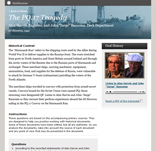As COVID-19 deaths spiked in 2020, Suzanne Firstenberg’s public art installation "In America: How could this happen…"
History Explorer Results (25)
Related Books (3)

Grade Range:
K-12
Resource Type(s):
Artifacts
Date Posted:
12/30/2020
Amber Melton made this robot at CompSciConnect, a University of Maryland camp. When few girls signed up for the university’s computer science classes, Dr. Jan Plane realized that something in the high schools wasn’t working. So she created a camp for middle schoolers to excite them about compute

Grade Range:
K-12
Resource Type(s):
Artifacts
Date Posted:
4/4/2016
Most incandescent lamps were designed for general use in homes and businesses. However, some required special features for use in particular locations. Westinghouse engineers designed this so-called mill lamp for use in factories and other areas subject to high levels of vibration. An intricate i

Grade Range:
K-12
Resource Type(s):
Artifacts
Date Posted:
4/4/2016
New United Motor Manufacturing Incorporated (NUMMI) was an auto manufacturing plant in Fremont, California, operated jointly by Toyota and General Motors from 1984 until 2010. GM had operated the plant at Fremont from 1960 where the clashes between management and union workers resulted in the pla

Grade Range:
K-12
Resource Type(s):
Artifacts
Date Posted:
3/28/2016
Before 1954, so-called portable radio receivers used vacuum tubes to receive and amplify signals. The large batteries needed to power most tubes made radios large and heavy. Receivers built with subminiature tubes existed but were expensive. The invention of transistors in 1947 allowed engineers

Grade Range:
6-12
Resource Type(s):
Reference Materials, Interactives & Media
Duration:
5 minutes
Date Posted:
5/15/2014
The history of patenting higher-level organisms began in the mid-1980s with a little guy called OncoMouse. In this episode, host Tory Altman joins Mallory Warner of the Museum's Division of Medicine and Science to talk about the first animal patented in the United States, and some of the ethical

Grade Range:
5-12
Resource Type(s):
Reference Materials
Date Posted:
9/4/2013
Between the years 1790 and 1880 the U.S. Patent Office required both documentation and a three-dimensional working model to demonstrate each new invention submitted for a patent. The models helped to explain proposed innovations and compare them against similar inventions. In this online exhibiti

Grade Range:
8-12
Resource Type(s):
Reference Materials
Duration:
5 minutes
Date Posted:
8/30/2013
In this post, readers join a New York architect in 1968 as he explores the usefulness of the Empire State Building and its potential for the future. Including a portion of the architect’s testimony to the Y Supreme Court, this blog asks readers to consider the non-monetary value of a stru

Grade Range:
5-12
Resource Type(s):
Reference Materials
Date Posted:
5/25/2012
This online exhibition tells of the development of COBOL, a computer programming lanugage, and how it changed the commercial, banking, and defense industries. Fifty years ago, each computer maker used its own programming languages to tell a computer what to do. In 1959, a group of programmer

Grade Range:
6-12
Resource Type(s):
Primary Sources, Interactives & Media, Lessons & Activities, Worksheets
Duration:
20 minutes
Date Posted:
4/6/2012
Alan Harvie and John “Sarge” Ransome served about the SS Honomu sailing the Murmansk Run to the Soviet Union. Listen to their story, and then study the supporting primary sources to answer the discussion questions. This resource is part of a series called “Maritime Voices: Merchant Ma

Grade Range:
6-12
Resource Type(s):
Interactives & Media, Worksheets
Date Posted:
8/15/2011
In 2005, Hurricane Katrina ravaged the Gulf Coast of the United States. In her wake, a team of curators from the museum set out to collect objects that captured the history of the moment and what it meant to the country. In this episode of the History Explorer podc












